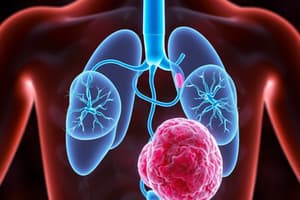Podcast
Questions and Answers
During glycolysis, which enzyme catalyzes the initial phosphorylation of glucose using ATP?
During glycolysis, which enzyme catalyzes the initial phosphorylation of glucose using ATP?
- Hexokinase (correct)
- Phosphofructokinase
- Pyruvate kinase
- Phosphoglycerate kinase
What is the primary role of triosephosphate isomerase in glycolysis?
What is the primary role of triosephosphate isomerase in glycolysis?
- To convert dihydroxyacetone phosphate (DHAP) into glyceraldehyde-3-phosphate (G3P) (correct)
- To catalyze the removal of water from 2-phosphoglycerate (2-PG)
- To split fructose 1,6-bisphosphate into two 3-carbon molecules
- To rearrange glucose-6-phosphate into fructose-6-phosphate
Which of the following correctly describes a product formed during the 'pay-off' phase of glycolysis?
Which of the following correctly describes a product formed during the 'pay-off' phase of glycolysis?
- Production of two NADH molecules catalyzed by phosphoglycerate kinase.
- Production of two ATP molecules catalyzed by pyruvate kinase. (correct)
- Generation of two ATP molecules by phosphoglycerate mutase.
- Formation of two pyruvate molecules through the action of enolase.
Which of the following is NOT directly involved in the endothermic/activation phase of glycolysis?
Which of the following is NOT directly involved in the endothermic/activation phase of glycolysis?
What is the net ATP production directly from glycolysis per molecule of glucose?
What is the net ATP production directly from glycolysis per molecule of glucose?
Flashcards
Glycolysis
Glycolysis
A cytoplasmic pathway breaking down glucose into two three-carbon compounds, generating energy.
Embden-Meyerhof-Parnas pathway
Embden-Meyerhof-Parnas pathway
Another name for glycolysis, named after its discoverers.
Energy Investment Phase
Energy Investment Phase
The first half of glycolysis where ATP is consumed to activate glucose.
Energy Payoff Phase
Energy Payoff Phase
Signup and view all the flashcards
Pyruvate production
Pyruvate production
Signup and view all the flashcards
Study Notes
Glycolysis Stages
- Glycolysis is a cytoplasmic pathway that breaks down glucose into two three-carbon compounds and produces energy.
- Also known as the EMP pathway (Embden-Meyerhof-Parnas pathway).
- Discovered by Gustav Embden, Otto Meyerhof, and Jakub Karol Parnas.
Endothermic/Activation Phase
- Glucose is phosphorylated by hexokinase using ATP.
- Rearrangement/isomerization using phosphoglucose isomerase.
- Second ATP phosphorylation catalyzed by phosphofructokinase.
- 6-carbon molecule (fructose 1,6-bisphosphate) is split into two fragments (dihydroxyacetone phosphate (DHAP) and glyceraldehyde-3-phosphate (G3P)) by aldolase.
- DHAP is converted to G3P.
Exothermic/Pay-off Phase
- Oxidation and phosphorylation catalyzed by glyceraldehyde-3-phosphate dehydrogenase, producing 2 NADH molecules and 2 BPG molecules.
- Phosphoglycerate kinase catalyzes the removal of high-energy phosphate from BPG by 2 ADP molecules, producing 2 ATP molecules.
- Rearrangement/isomerism by phosphoglycerate mutase.
- Enolase catalyzes the removal of water and produces 2 PEP molecules.
- Removal of high-energy phosphate from PEP by 2 ADP molecules produces 2 ATP molecules and 2 pyruvate molecules through the use of pyruvate kinase.
Studying That Suits You
Use AI to generate personalized quizzes and flashcards to suit your learning preferences.
Related Documents
Description
Explore the endothermic (activation) and exothermic (pay-off) phases of glycolysis, the cytoplasmic pathway that breaks down glucose. Learn about key enzymes like hexokinase, phosphofructokinase, and glyceraldehyde-3-phosphate dehydrogenase and their roles in ATP and NADH production.




